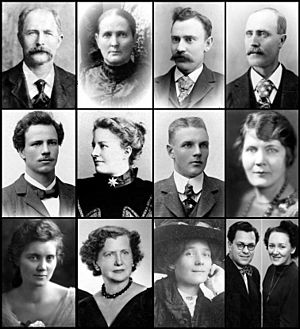Swedish emigration to the United States facts for kids
During the Swedish emigration to the United States in the 19th and early 20th centuries, about 1.3 million Swedes left Sweden for the United States. This was a huge movement of people!

Many things made Swedes want to leave their home country. The United States had lots of open land, which was like a magnet for poor farmers in Europe. But some things in Sweden made people especially want to go.
The Swedish Lutheran State Church was very strict about religion. People felt like they couldn't worship freely. Also, the Swedish monarchy and upper classes were very traditional and often looked down on people from lower social groups.
Life in the Swedish countryside was also getting harder. There were more people, and sometimes crops didn't grow well. This meant less food and more poverty.
On the other hand, early Swedish immigrants sent back exciting news. They described the American Midwest as a wonderful place, almost like a paradise.
According to expert Joy K. Lintelman, this big move from Sweden to the U.S. happened in five main periods between the 1840s and 1920s. Hundreds of thousands of Swedes settled in both cities and rural areas across the U.S.
This large-scale migration started to slow down for reasons on both sides of the Atlantic. The U.S. began to set limits on how many people could immigrate. At the same time, life in Sweden started to get better, with more jobs and improved living conditions.
Contents
When Most Swedes Left
The number of Swedes moving to the U.S. was highest in the years after the American Civil War (1861–1865). By 1890, the U.S. census showed nearly 800,000 Swedish-Americans.
Sweden became worried about so many people leaving. But before they could make big changes to stop it, World War I (1914–1918) started. This war made it very hard to travel, and the mass emigration from Sweden mostly stopped by the mid-1920s.
Remembering the Journey
The most famous story about Swedish emigration is a series of four novels called The Emigrants. These books were written by Vilhelm Moberg between 1949 and 1959.
The novels tell the story of one family's journey and their lives in America over many years. They have sold almost two million copies in Sweden and have been translated into over twenty languages.
These books were also made into two movies: The Emigrants (1971) and The New Land (1972). They also inspired Kristina from Duvemåla, a musical from 1995 by former ABBA members Benny Andersson and Björn Ulvaeus.
Places to Learn More
In Sweden, the city of Växjö has the Swedish Emigrant Institute. It was started in 1965 to keep records, interviews, and items from the time of the big Swedish emigration (1846 to 1930).
The House of the Emigrants (Emigranternas Hus) opened in Gothenburg in 2004. Gothenburg was the main port where Swedish emigrants boarded ships. This center has exhibits about migration and a research room for people looking into their family history.
In the U.S., there are hundreds of active Swedish-American groups. The Swedish Council of America helps to connect these groups. You can find Swedish-American museums in cities like Philadelphia, Chicago, Minneapolis, and Seattle.
Old cemeteries, like the Moline Swedish Lutheran Cemetery in central Texas, also help us remember the first Swedes who came to the United States.
Images for kids
-
In the Land of Promise, Castle Garden, 1884, by Charles Frederic Ulrich, showing the Emigrant Landing Depot in Manhattan.
-
Swedish emigrants boarding a ship in Gothenburg in 1905.
-
Map showing where Swedish Americans lived in 2000, according to the United States Census.
See also
 In Spanish: Inmigración sueca en los Estados Unidos para niños
In Spanish: Inmigración sueca en los Estados Unidos para niños








